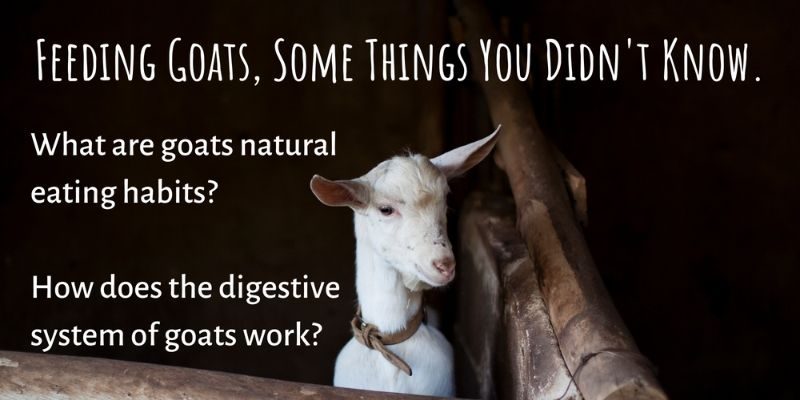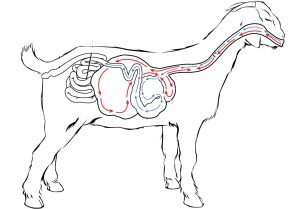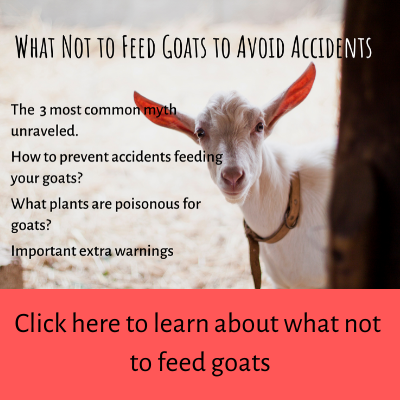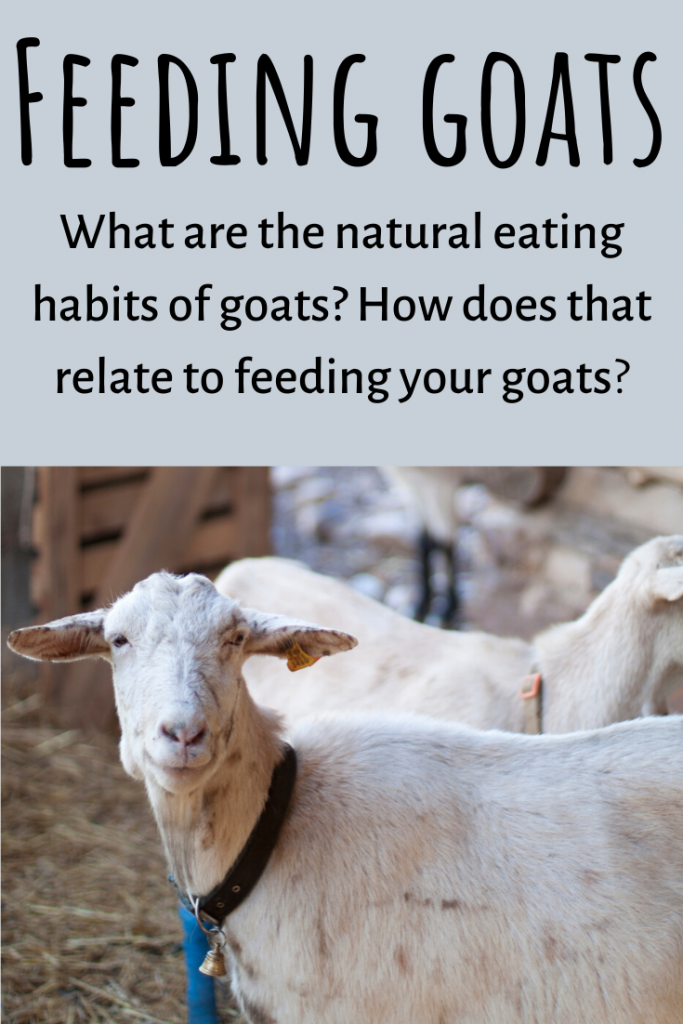
Can you give me the name of a country were there are no goats?
No? Why not? Because they are very flexible in their diet.
Does that mean goats eat everything? No, definitely not.
How does that work?
Let’s look into goats natural eating habits and how their digestive system works.
Why would we look into that, what does that have to do with feeding goats? Because knowing about goats eating habits and their digestive system means that you will easily understand what to feed and not feed your goats.
What is in this blog?
Wouldn’t it be great if we would be able to travel back in time and see how goats used to live in their natural environment?
Just imagine a world in which small numbers of humans live. Many grazers were inhabiting the world, amongst them goats. The goats lived everywhere on our planet, from the poles to the tropics. Roaming around on steppes, on open spaces between the dense rain forest, on freezing mountaintops and many more places.
The diet of the goats would change with the seasons. They are flexible in what they eat so they would have had a good chance of surviving.
They would eat shrubs, herbs, grass, trees, vines, bark, twigs, fallen leaves, berries, fruit, pods (like alfarroba), aceorns, chestnuts and much more.
Goats would find something to eat in any season.
In this area where we live, around the Mediterranean they would eat fresh herbs, grasses and shrubs shoots in the wet and mild winters.
During the long dry summers they would have to put more effort in gathering their food. They would have to walk up to 9 km a day to fill their stomachs and eat seeds, bark from trees, twigs, bushes, hay and other dry forage.
Can you picture what they would have eaten where you live? In summer and in winter?
Since there were predators all over the place, they would not eat all day.
During the hours of sunrise and sunset they will go quickly into the open fields to forage as much as they can, then when the sun rises more up, the goats would withdraw into the wood edges to hide and ruminate their food.
At night they would do the same, they would spend the nights hidden in the shrubby wood edges and not make a sound. Silently ruminating.
The way the goats digestive system works is perfect to quickly eat as much as possible and then after they have filled their stomach draw back into the scrubs and start ruminating.
Goats have a stomach that has 4 parts. The first part of their stomach, they can fill with very roughly chewed material. This way they can eat large quantities in a very short time.
This first part of the stomach pushes the food plus a load of saliva back up into their mouth. Then the goats take their time chewing it properly. This is called ruminating.

After that the well chewed food is swallowed again and digested by millions of microbes: bacteria, fungus and yeasts that live in the second part of the stomach.
The red and blue arrows in the drawing show the route that the food is taking inside the goat.
The microbes live in a symbiosis with the goat: the goat provides them with raw food material that is well chewed and the microbes provide the goat with their waste which is digestible for the goat.
In the goat’s stomach the bacteria, fungi and yeasts form a sensitive ecosystem that needs to be treated with care. The numbers of the different bacteria, fungi and yeasts colonies are carefully balanced. A sudden change in food for the goat would cause an imbalance that can make the goat ill because the microbes would not be able to deal with it. An imbalance can even kill a goat when it gets too extreme.
So when you are feeding your goat, you are not only feeding your goat, but also this sensitive ecosystem. You will need to feed this ecosystem with care.
To maintain this ecosystem you will need to give your goats food with enough long fibers, which are mainly present in hay and grasses. The goats can only be fed grains (starch) in moderation. Greens of all sorts will provide vitamins and minerals to the goats as well.
Do not feed goats food that is not suitable for goats. The microbes will not be able to handle it. Giving goats feed that is for sheep is still acceptable, but it is the only one.
 Hay can be given at all times and can be freely available. So can greens, when goats are used to them. If goats did not eat greens for a long time, like in winter, you will have to start with small portions. If not you will disrupt the ecosystem in their stomach.
Hay can be given at all times and can be freely available. So can greens, when goats are used to them. If goats did not eat greens for a long time, like in winter, you will have to start with small portions. If not you will disrupt the ecosystem in their stomach.
Changing food for goats is a sensitive story. You will have to change their food gradually so the microbes can adjust.
After being in the second part of the stomach, the food is then digested in two more steps in the third and fourth part of the stomach. After that is is taken through the intestines where nutrition is taken out of the digested food. What is left goes out at the other end, where we can see it again as the little poop pellets that drop out of the goat.
When their poop comes out in little loose pellets this means the digestive system is working as it should. When it is sticking together or comes out in the form of diarrhea there might be a too sudden change of food or the food might be too rich. It can also have happened that a goat has eaten something that it should not have eaten, goats do make mistakes.
Oh, no!
Despite of the quick eating the goats would still be picky, they would first explore the field they are in, sniffing the food that they are going to eat. Thinking: “do I like this? Is it mouldy? If it’s mouldy I will not eat it. Does it taste wrong? I will spit it out”.
After some exploring they will go ahead and eat, with confidence, as much of the good stuff they found.
Goats can also get too picky, so picky that they do not meet their nutritional needs by eating. Sometimes they can also pick out things that are not so good for them. Pretty much like we humans do, by eating too many muffins and not eating enough fruit and vegetables.
Goats have a preference for woody plants, but they do well on grasses, herbs and shrubs as well. They especially love the fresh parts of the plants.
Watch the goats picking and browsing their food in the video below.
When we keep goats we usually contain them and controle their food by feeding them. That is fine.
Goats have preference for variety in their diet, this will keep them healthy. This does not mean that you will have unhealthy goats when you keep them and controle their food. They are after all flexible in their diet too.
Long time ago humans and goats decided to work together. It was a mutual interest.
Goats would be provided with safety, shelter and food and humans would also have more food security because the goats offered them their milk and offspring.
For long shepherds would walk around with goats and still today goats are kept in that way.
Shepherds would take the goats through the landscape for days. Maintaining the landscape and feeding the goats at the same time. Whether the landscape was poor or rich, what was there was all that the goats ate.
Taking goats around like a shepherd does not always mean that the goats will get everything they need. It depends a lot on what is available. And even if everything is available goats can be picky against their own interest.
Apart from herding goats, additional feeding of goats can be a good thing. This can make the goats stronger and makes them give more milk or better meat. It can also prevent the loss of goat kids at an early age.
In more industrialised areas goats are often kept inside in big barns. The feed these goats get seems to be far off from the diet that they used to have.
These goats are often fed hay (free available), alfalfa hay (substitute for greens) and pellets or grains.
The pallets and grain mixes that are fed to these goats are based on what goats used to eat and how their digestive system works. The composition of these feeds are based on studies on what goats can digest. Tables and calculations preceded the production of these feeds.
Goats are very flexible indeed.
Goats are ruminants. Ruminants live in symbiosis with the microbes that live in their stomach. The microbes digest the food that a goat eats for the goat. Feeding a goat means feeding her stomach microbes. The microbes in the stomach form a sensitive ecosystem that has to be treated with care e.g. by not changing food abruptly or not giving the goat food that is not suitable for goats (like chicken feed or pork feed). Feed that is for sheep is still acceptable.
Goats natural diet contains a lot of long fibers, there is not so much starch in it. Grains mixes and feed pellets contain short fibers and lots of starch. These feeds should not be given in big quantities. This will make the microbes in their stomach unhappy.
Hay also has a lot of long fibers. It is good to have hay always available for your goats.
Goats like fresh greens because they contain a lot of energy. Fresh greens are healthy for goats. It contains fibers, vitamins and minerals. When given in a large variety it is good food for goats, it will provide them with all their needs. A pasture or shrub field with a good variety of herbs, shrubs, trees and grasses provides good food for goats.
but the way their digestive system works has to be taken into account. E.g. goats can live on a diet of hay, alfalfa hay and pellets for ever. As long as there are no sudden changes in this diet and the food that is given is suitable for goats. The food that is given needs to be of a good quality so the goats nutritional needs are met.
In a situation where there are predators goats will eat in the early morning and evening when predators are less active. In a save situation like on your property they can adapt the rhythm to the circumstances.
This can be a rhythm of eating for 2 hours and resting for halve an hour. This can even continue during the night.
This means that goats like to walk in and out of their shelter to get a bite. When they are free ranged. When goats are living indoors or staying indoors at night for safety reasons it is nice for them if they have hay free available, this way they can eat whenever they like.
How does a rumen work? The system of all ruminants works basically the same. Goats, sheep and cows are all ruminants. This video, which is about a cows stomachs, explains in more detail how the rumination process works, it also stresses the role of the microorganisms in the stomach. What is explained in this video also counts for goats.
Digestion in ruminants. A detailed description of the whole digestive system of ruminants. The symbiosis between the micro-organismes and the ruminant is explained in detail.
Ruminant stomach-structure and function. Short explanation of the ruminants digestive system.
Rumen microbial fermentation. The ecosystem and the importance of it’s balance in the ruminants stomachs in detail. What is described also counts for goats.
Het graasgedrag van de landgeit in Nederland, en verkenning (Grazing habit of the country goats in the Netherlands, and reconnaissance) Anneke de Vries & Nick van Eekeren,© [2007] Louis Bolk Instituut, the Netherlands.
